|
|
Top 10 Most Venomous Snakes
Venomous snakes have fascinated and instilled fear in humans for centuries. These remarkable creatures are a diverse group of reptiles that have evolved to inject potent toxins into their prey, aiding in the process of immobilization and digestion. This informational text provides an overview of venomous snakes, their characteristics, distribution, and the importance of understanding and respecting them in their natural habitats.
Venomous snakes are among the most feared and deadly creatures on Earth. While these reptiles come in various shapes and sizes, their venomous capabilities are a source of fascination and caution. Top 10 videos introduces you to the ten most venomous snakes in the world, shedding light on their unique characteristics, geographic distributions, and the potential risks they pose to humans.
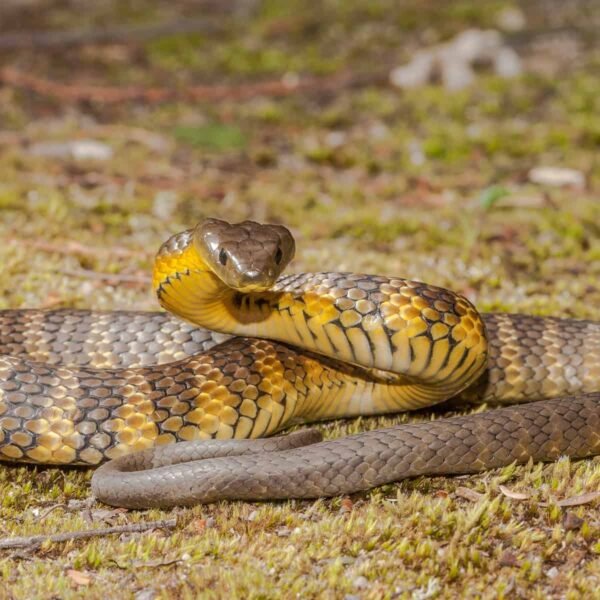
10 - Mainland Tiger Snake
The Black-banded Sea Krait, scientifically known as Laticauda semifasciata, is a unique and highly venomous sea snake species found in the warm waters of the western Pacific Ocean. It is part of the Elapidae family, which includes some of the world’s most venomous snakes. Sea kraits are characterized by their aquatic lifestyle and are well adapted to life in the ocean.
Key Characteristics:
- Appearance: Black-banded Sea Kraits have a striking appearance with distinctive black bands alternating with lighter yellow or blue-gray bands along their body. They possess a flattened, paddle-like tail, which aids in swimming.
- Size: They are moderately sized sea snakes, with adult individuals typically ranging from 70 to 100 cm (about 28 to 39 inches) in length.
- Venom: These sea snakes have potent venom, which is primarily neurotoxic. However, they are known for their docile and non-aggressive nature, and they are unlikely to bite unless severely provoked.
- Location: Wales, Australia, Tasmania.
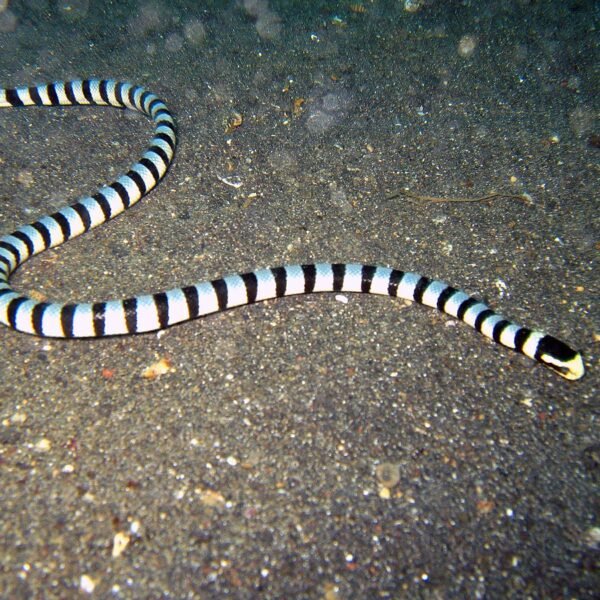
9 - Black-banded Sea Krait
The Mainland Tiger Snake, scientifically known as Notechis scutatus, is a venomous snake species native to Australia. It belongs to the family Elapidae, which includes some of the world’s most venomous snakes. Mainland Tiger Snakes are known for their striking appearance, potent venom, and relatively wide distribution across southeastern Australia.
Key Characteristics:
- Appearance: Mainland Tiger Snakes exhibit a distinctive pattern of dark crossbands against a light-colored background. This pattern often resembles the stripes of a tiger, hence their name. However, the coloration can vary, and some individuals may have olive, yellow, or even completely black scales.
- Size: These snakes are moderately sized, with adult individuals typically reaching lengths of 3 to 4 feet (0.9 to 1.2 meters). However, some specimens can grow larger.
-
Venom: Mainland Tiger Snakes possess highly potent neurotoxic venom, which can cause paralysis and other severe symptoms in their prey and, if bitten, in humans. The venom is delivered through fangs located at the front of their mouths.
- Location: Indonesia, Philippines, Thailand, Papua New Guinea, Solomon Islands, Australia.
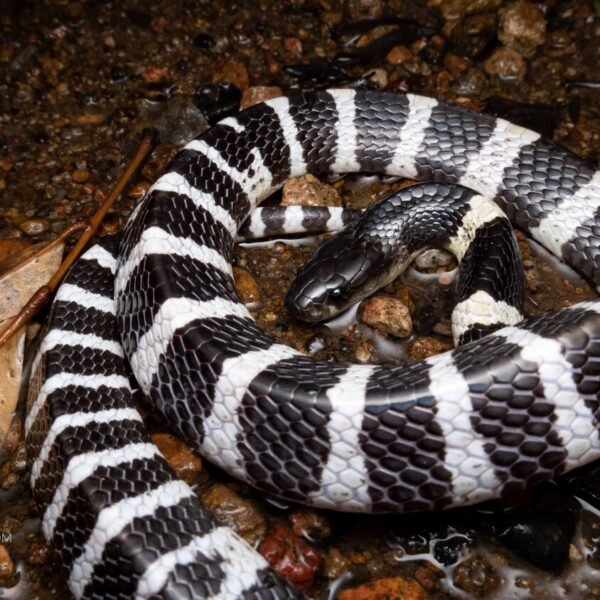
8 - Many-Banded Krait
The Many-Banded Krait, scientifically known as Bungarus multicinctus, is a highly venomous snake species found in various parts of Southeast Asia and southern China. It is a member of the Elapidae family, which includes some of the world’s most venomous snakes. Many-Banded Kraits are known for their striking banded pattern and potent neurotoxic venom.
Key Characteristics:
- Appearance: The Many-Banded Krait displays a distinctive and eye-catching appearance with alternating black and yellow or white bands along its body. These bands give it a striking resemblance to a banded pattern, which serves as a warning to potential predators.
- Size: Adult Many-Banded Kraits typically measure between 80 to 100 cm (31 to 39 inches) in length, although some individuals can grow larger.
- Venom: Their venom is highly neurotoxic, affecting the nervous system and causing paralysis. This venom can be particularly potent and potentially fatal if not treated promptly.
- Location: Taiwan, Hong Kong, Myanmar, Laos, Vietnam, Thailand
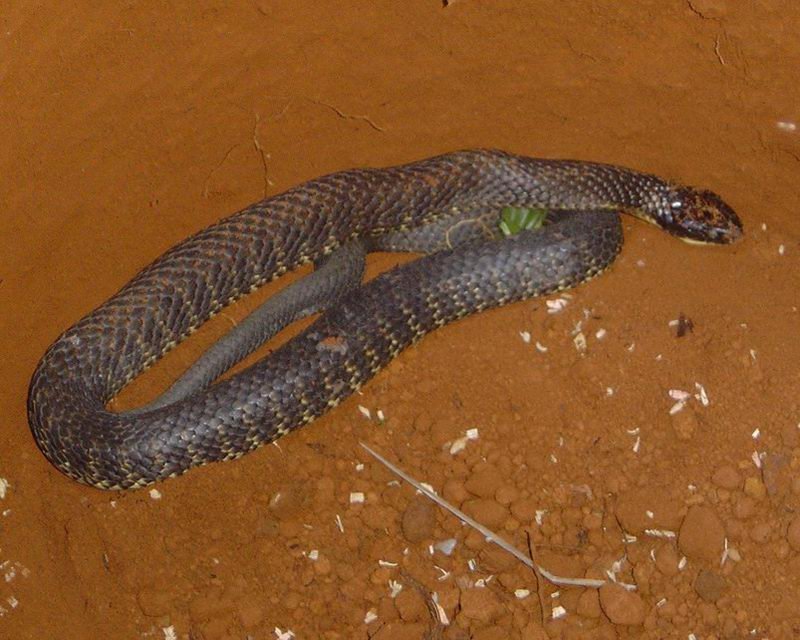
7 - Tiger Snake
Tiger Snakes are a group of venomous snakes primarily found in the southern regions of Australia. These snakes belong to the Elapidae family, which includes some of the world’s most venomous species. There are several distinct species within the Tiger Snake genus, but they share common characteristics.
Key Characteristics:
- Appearance: Tiger Snakes are known for their striking appearance, with bands or stripes that often resemble a tiger’s stripes. However, the coloration can vary significantly, ranging from olive to brown to black, with contrasting bands of yellow or cream.
- Size: Adult Tiger Snakes typically range from 1 to 1.5 meters (3 to 5 feet) in length, although some individuals may grow larger.
- Venom: Tiger Snakes possess potent venom that is both neurotoxic and cytotoxic. Their venom can cause paralysis, muscle pain, and local tissue damage, which can be life-threatening if not treated promptly.
- Location: Australia.
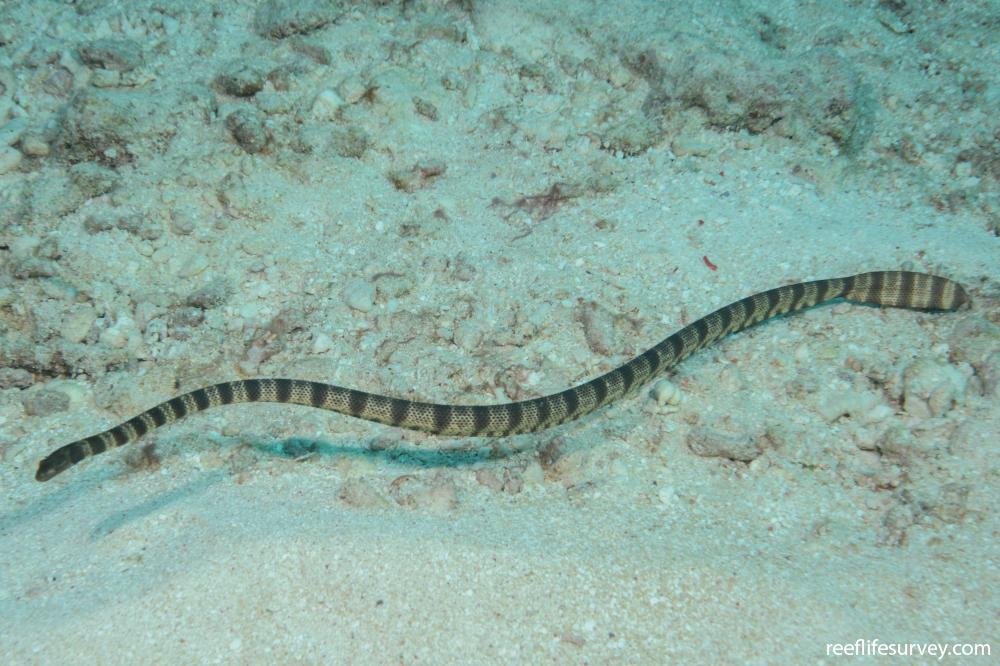
6 - Acalyptophis Peronii
Peron’s Sea Snake, scientifically known as Hydrophis peronii, is a species of highly venomous sea snake found in the waters of the Indian and western Pacific Oceans. It is a member of the family Elapidae, which includes other venomous snakes such as cobras and mambas. Peron’s Sea Snake is known for its distinctive appearance and unique adaptations for life in the marine environment.
Key Characteristics:
- Appearance: Peron’s Sea Snake has a sleek and elongated body, which is adapted for swimming. Its coloration can vary, but it typically has a dark, sometimes bluish-black upper body with a lighter belly.
- Size: Adult Peron’s Sea Snakes can reach lengths of up to 80-100 centimeters (about 31-39 inches). They have flattened tails and are well-adapted for aquatic life.
- Venom: These sea snakes have highly potent venom, which is primarily neurotoxic. Their venom can paralyze and immobilize their prey, which primarily consists of small fish and eels.
- Location: Indonesia, Philippines, Thailand, Australia, Vietnam, China, Taiwan, New Caledonia.
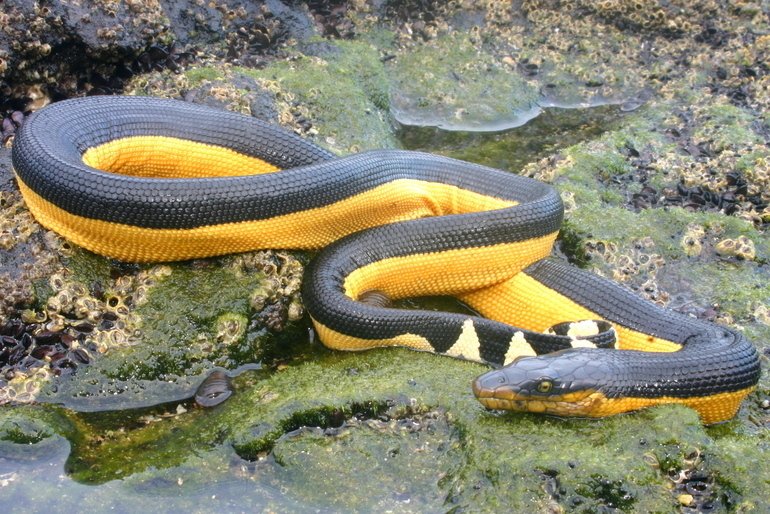
5 - Pelamis Platura
The Yellow-Bellied Sea Snake, scientifically known as Pelamis platura, is a remarkable and highly venomous marine snake found in the warm waters of the Indian and Pacific Oceans. It is a member of the family Elapidae, which includes other venomous snakes like cobras and mambas. The Yellow-Bellied Sea Snake is renowned for its aquatic adaptations and unique lifestyle.
Key Characteristics:
- Appearance: Yellow-Bellied Sea Snakes have a sleek, cylindrical body that is adapted for swimming. Their coloration varies, but they generally have a yellow or light-colored belly and a dark-colored back. They lack ventral scales, making their underbelly highly flexible for swimming.
- Size: Adult Yellow-Bellied Sea Snakes can reach lengths of up to 90-110 centimeters (about 35-43 inches).
- Venom: These sea snakes possess potent venom, which is primarily neurotoxic. Their venom can immobilize and subdue their prey, which mainly consists of small fish and eels.
- Location: Madagascar, India, Indonesia, Japan, Australia, New Zealand.
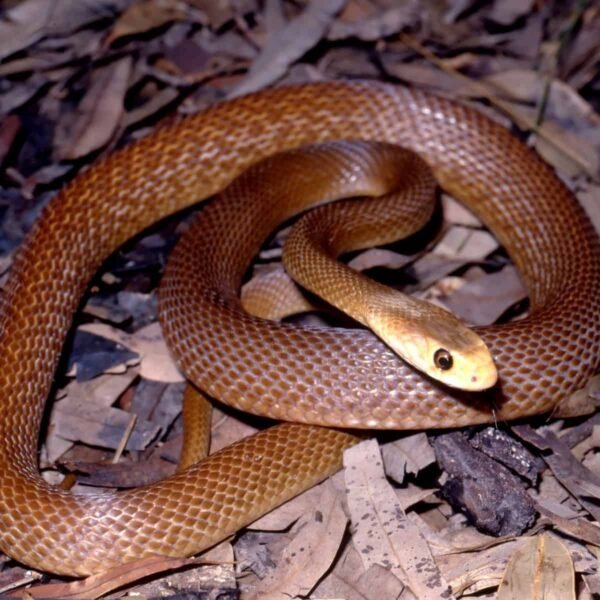
4 - Coastal Taipan
The Coastal Taipan, scientifically known as Oxyuranus scutellatus, is a highly venomous snake species native to northern and eastern Australia and parts of New Guinea. It is one of the world’s most venomous land snakes and is known for its potent neurotoxic venom. The Coastal Taipan is part of the Elapidae family, which includes other venomous snakes like cobras and mambas.
Key Characteristics:
- Appearance: Coastal Taipans are slender snakes with a light to dark brown coloration on their upper body and a lighter underside. They have a distinctively pointed head and large eyes with round pupils.
- Size: Adult Coastal Taipans can reach lengths of up to 2 meters (around 6.5 feet), making them one of the longest venomous snakes in the world.
- Venom: Their venom is highly neurotoxic, affecting the nervous system, and can cause paralysis, respiratory failure, and other severe symptoms. Bites from Coastal Taipans can be fatal if not treated promptly.
- Location: Australia.
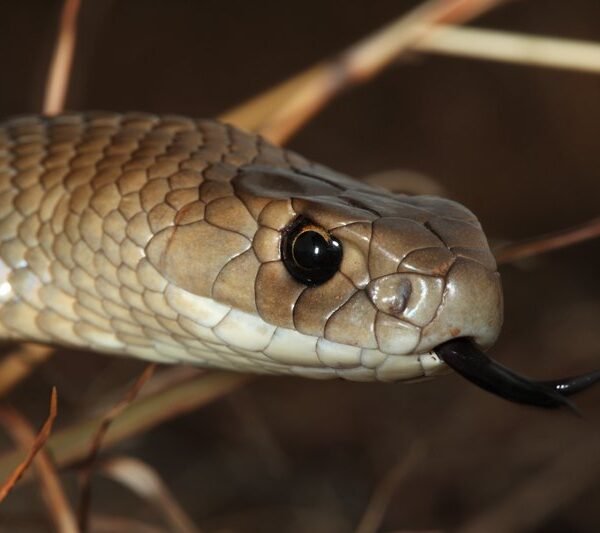
3 - Eastern Brown Snake
The Eastern Brown Snake, scientifically known as Pseudonaja textilis, is a highly venomous snake species native to eastern and southeastern Australia. It is one of the most venomous land snakes in the world and belongs to the family Elapidae, which includes other venomous snakes like cobras and mambas.
Key Characteristics:
- Appearance: Eastern Brown Snakes are slender snakes with variable coloration. They can range from light to dark brown, with a creamy or pale-colored belly. The head is often slightly broader than the neck, and the eyes have round pupils.
- Size: Adult Eastern Brown Snakes can vary in size but typically reach lengths of 1.2 to 1.8 meters (4 to 6 feet), although some individuals may grow larger.
- Venom: Their venom is highly potent and primarily neurotoxic, affecting the nervous system and potentially causing paralysis, muscle damage, and other severe symptoms. Bites from Eastern Brown Snakes can be fatal if not treated promptly.
- Location: Tasmania, Papua New Guinea, Australia.
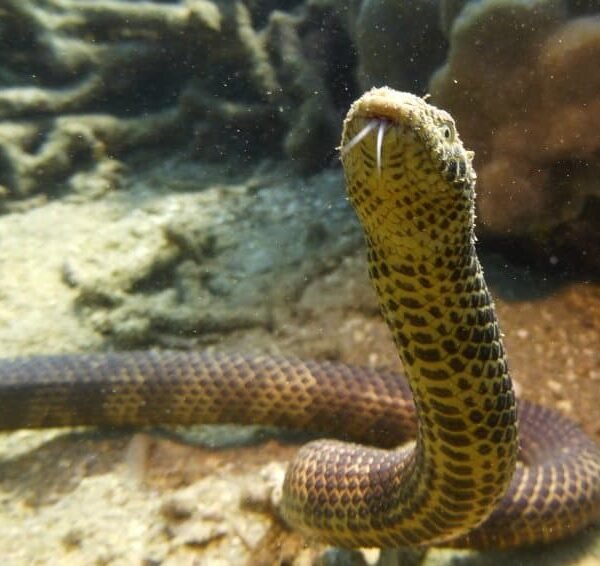
2 - Aipysurus Duboisii (Deadly sea snake)
Dubois’s Sea Snake, scientifically known as Aipysurus duboisii, is a highly venomous and unique marine snake species found in the waters of the Indian and Pacific Oceans. It is a member of the Elapidae family, which includes other venomous snakes such as cobras and mambas. Dubois’s Sea Snake is known for its distinctive appearance and remarkable adaptations for life in the marine environment.
Key Characteristics:
- Appearance: Dubois’s Sea Snake has a slender and elongated body, specially adapted for swimming. Its coloration is typically dark brown to black on the upper body and light-colored underneath. It has a distinctive laterally compressed tail, which acts as a paddle for efficient swimming.
- Size: Adult Dubois’s Sea Snakes can reach lengths of up to 60-90 centimeters (about 24-35 inches).
- Venom: These sea snakes possess highly potent venom, which is primarily neurotoxic. The venom can immobilize and subdue their prey, which mainly consists of small fish and eels.
- Location: Australia.
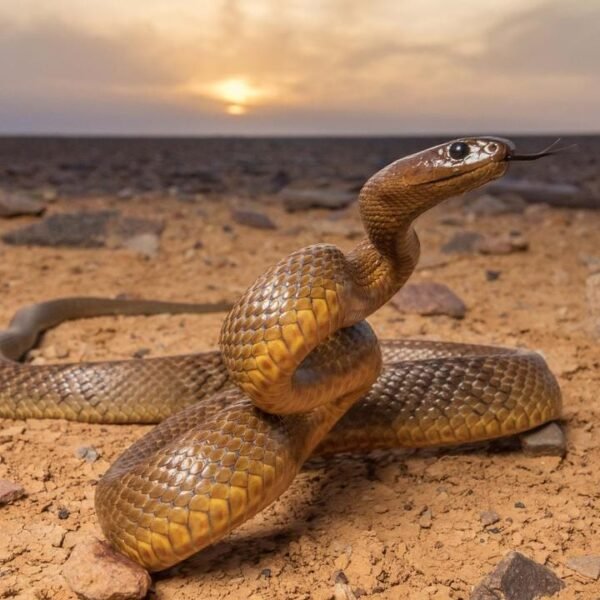
1 - Inland Taipan
The Inland Taipan, scientifically known as Oxyuranus microlepidotus, is considered the most venomous snake in the world. This highly venomous snake is native to the arid regions of Australia and is renowned for its potent venom, but it is also known for its secretive and reclusive nature.
Key Characteristics:
- Appearance: Inland Taipans are relatively small snakes with a slender body and a distinctive coloration. They have scales that vary in color, usually light olive or brown, with scattered dark bands on their body. Their head is slightly darker than the body.
- Size: Adult Inland Taipans typically measure 1.5 to 2 meters (about 4.9 to 6.6 feet) in length.
- Venom: The Inland Taipan’s venom is extremely potent and is primarily neurotoxic. It contains powerful toxins that can cause paralysis and death in a very short time if left untreated. Despite their highly toxic venom, these snakes are not aggressive and rarely bite humans.
- Location: Australia.













































